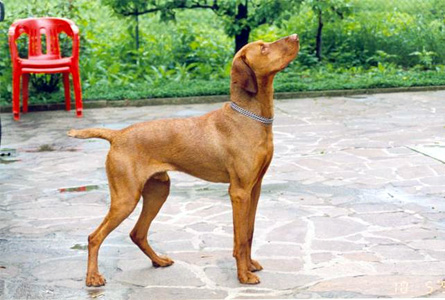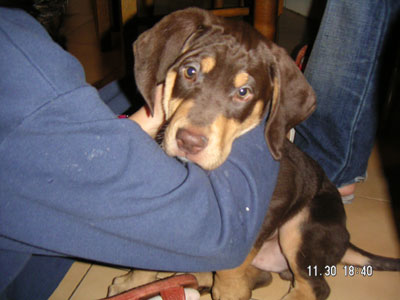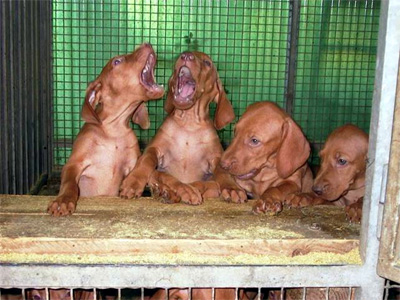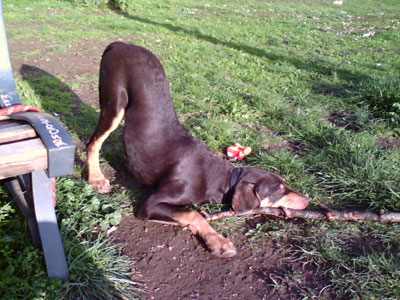HUNGARIAN WIRE-HAIRED POINTER (VIZSLA) (Drotzörü Magyar Vizsla)

FCI-Standard N° 239 / 13.09.2000 / GB
TRANSLATION: Mrs. H. Gross-Richardson and Mrs. Ann Mitchell, ANKC Australia and Mrs. Elke Peper.
ORIGIN: Hungary.
DATE OF PUBLICATION OF THE ORIGINAL VALID STANDARD: 06.04.2000
UTILISATION: A versatile gun dog that must be able to work in the field, forest and water, having the following typical qualities: an excellent nose, firmness on the point, excellent retrieves and determination to remain on the scent even when swimming, which he manifestly enjoys. He copes with difficult terrain as well as extreme weather conditions. As he is intended to be an efficient hunting dog, gun and game shyness, unwillingness to point and retrieve, as well as a dislike of water are undesirable. Because of his easy going nature and his adaptability, he can easily be kept as a companion dog in the house.
CLASSIFICATIONGroup 7 Pointing Dogs.
Section 1 Continental Pointing Dogs.
With working trial (Field and Water Trial)
BRIEF HISTORICAL SUMMARYThe Hungarian Wire-Haired Vizsla was created by cross-breeding the Hungarian Short-Haired Vizsla with the German Wire-Haired Pointer during the 1930‘s. His breed characteristics are identical with those of the Hungarian Short-Haired Vizsla.
GENERAL APPEARANCE : A lively, russet gold hunting dog of dry and lean but more robust construction compared to the Hungarian Short-Haired Vizsla.
His appearance embodies his qualities as a multi-purpose pointing dog, endurance, working ability and an easily satisfied nature.
IMPORTANT PROPORTIONS
- The body length slightly exceeds the height at the withers.
- The depth of the brisket is slightly less than half the height at the withers.
- The muzzle is slightly shorter than half the length of the head.
BEHAVIOUR/TEMPERAMENT : An affectionate and intelligent dog, selfconfident, easily trained, which cannot bear rough treatment. He keeps contact with his handler, is passionate in his quest, is stubborn, has a good nose and is staunch on the point.
SUGGESTED BREEDINGS by MENANDPETS.COM:
No breeding to signal
if you want to know like signaling yours, contacts: marketing@inseparabile.it
HEAD
CRANIAL REGION
Skull : Moderately wide, slightly domed. A slightly pronounced groove runs from the moderately developed occiput towards the stop. The superciliary ridges are moderately developed.
Stop : Moderate.
FACIAL REGION
Nose : Broad and well developed with nostrils as wide as possible. The colour of the nose harmonises in a dark shading with the coat colour.
Muzzle : Blunt, not pointed, with powerful jaws, strongly muscled. The bridge of the nose is straight
Lips : Tightly fitting, no pendulous flews.
Jaws/Teeth : Powerful jaws with a perfect, regular and complete scissors bite, the upper teeth closely overlapping the lower teeth and set square to the jaws ; with 42 healthy teeth according to the dentition formula.
Cheeks : Strong, well muscled.
Eyes : Slightly oval, of medium size, well fitting eyelids. Intelligent and lively expression. The brown eye colour harmonising with the coat colour, as dark as possible preferred.
Leathers : Set on at medium height, a little backwards, hanging closely to the cheeks, ending in a rounded V shape. Slightly shorter than those of the Hungarian Short-Haired Vizsla.
NECK : Of medium length, harmonising with the overall appearance. The nape very muscular and slightly arched. Tightly fitting skin at the throat.
BODY
Withers : Pronounced and muscular.
Back : Solid, well muscled, taut and straight. The vertebral spines should be hidden by the muscles.
Loin : Short, broad, tight, muscular, straight or slightly arched. The loin is well attached.
Croup : Broad and of sufficient length, not cut off short, sloping slightly to the tail. Well muscled.
Chest : Deep and broad with well developed well muscled and moderately arched forechest, sternum extending as well back as possible. The sternum and the elbows should be at the same level. Last ribs moderately arched. Ribs carried well back.
Underline : Elegant, tight, arching towards the rear, slightly tucked up.
TAIL : Set on at medium height, strong at the base, then tapering. In countries where tail docking is not prohibited by law, the tail may be shortened by one quarter to avoid hunting hazards. If the tail docking is prohibited, the tail reaches down to the hock joint and is carried straight or slightly sabre like. On the move, it is raised up to the horizontal. The tail is well furnished with dense coat.
LIMBS
FOREQUARTERS : Viewed from the front, straight and parallel. Viewed from the side, legs vertical and placed well under the body. Good bone, well muscled.
Shoulders : Long, sloping and flat, well attached shoulder blade. Elastic when moving. Strong, dry muscles. Well angulated between shoulder blade and upper arm.
Upper arm : As long as possible, well muscled.
Elbows : Close to the body, however not tied in, turning neither in nor out. Well angulated between upper arm and forearm.
Forearm : Long, straight, sufficiently muscled. Bones strong, but not coarse.
Pastern joint : Dry, sinewy.
Pastern : Short. Only very slightly sloping.
Forefeet : Slightly oval, with well knit, sufficiently arched, strong toes. Strong brown nails. Tough, resistant, slate grey pads. The feet are parallel when standing or moving.
HINDQUARTERS : Viewed from GO BACK TO LIST, straight and parallel. Good angulations. Strong bone.
Upper thigh : Long and muscular. Good angulation between pelvis and upper thigh.
Stifle : Well angulated.
Lower thigh : Long, muscular and sinewy. Its length is almost equal to that of the upper thigh. Good angulation between lower thigh and metatarsus.
Hock joint : Strong, dry and sinewy, rather well let down.
Metatarsus : Vertical, short and strong.
Hind feet : Similar to forefeet.
GAIT/MOVEMENT : The typical gait is an animated, light-footed trot, elegant and far reaching, with much drive and corresponding reach. Not exhausting gallop when working in the field. The back is firm and the topline remains level. Pacing is undesirable.
SKIN : Tightly fitting, without folds. The skin is well pigmented.
COAT
HAIR : Wiry, close lying, strong, dense and not glossy. Length of outer coat 2-3 cm; dense, water repellent undercoat. The outline of the body must not be hidden by the longer coat. By its hardness and density, it should provide as much protection as possible against weather conditions and injuries. The lower parts of the legs as well as the undersides of chest and belly should be covered with shorter, softer and slightly thinner hair; the coat on the head and on the leathers is shorter and, at the same time, a little darker, however, not soft and dense.
Pronounced eyebrows accentuate the stop. These and a strong, not too long (2-3 cm), as harsh as possible beard, on both sides of the muzzle, underline the determined expression. On both sides of the neck the coat forms V-shaped brushes.
COLOUR : Various shades of russet gold and dark sandy gold (semmelgelb). The leathers may be a little darker, otherwise uniform in colour. Red, brownish, light yellow or lightened colour shadings are undesirable. A little white patch on the chest or at the throat, not more than 5 cm in diameter, as well as white markings on the toes, are not considered faulty. The colour of the lips and of the eyerims corresponds to the colour of the nose.
SIZE/WEIGHT
HEIGHT AT WITHERS
Dogs: 58 - 64 cm
Bitches: 54 - 60 cm
It is ineffective to increase the height at the withers. A medium size should be aimed at. Overall balance and symmetry are much more important than the mere measurable size.
FAULTS : Any departure from the foregoing points should be considered a fault and the seriousness with which the fault should be regarded should be in exact proportions to its degree.
ELIMINATING FAULTS
- Aggresive or overly shy.
- Strong deviation from the sexual characteristics.
- Atypical head.
- Spotted(butterfly) nose.
- Pendulous or dribbling flews.
- Under- or overshot mouth. Wry mouth, including all intermediate forms.
- One or more missing incisors and/or canine and/or premolars 2-4 and/or molars 1-2 ; more than two missing PM1 ; the M3 are disregarded. Not visible teeth are assessed as missing ones.
- Supernumerary teeth not in line with the others.
- Cleft palate, harelip.
- Light yellow eyes. Very loose eyelids; ectropion, entropion. Distichiasis (double row of eyelashes).
- Pronounced dewlap.
- Dewclaws
- Very faulty movement.
- Thin coat, lacking undercoat. Long, soft, silky, shaggy, crinkle or woolly coat. Lacking brushes on the legs.
- Dark brown or pale yellow colour. Particoloured, not uniformly coloured. White chest patch larger than 5 cm.
- White feet.
- Lacking pigmentation either on the skin or on the lips and eyerims.
- Any type of weakness in temperament.
- Deviation of more than 2 cm from the above mentioned heights at withers.
Any dog clearly showing physical or behavioural abnormalities shall be disqualified.
NB: Male animals must have two apparently normal testicles fully descended into the scrotum.
automatic translate from inseparabile.com
Character: Assets, clever, giocherellone and with the children small a lot coccolone! This race and a much fast and much skillful but also po testardino in respecting of the rules being alone.

In the Max photo the vizsla of Nicholas Ana
STANDARD
The ICF
N 57 of
13/09/2000.
HOUND HUNGARIAN To SHORT HAIR
ORIGIN: Hungary.

In the Max photo the vizsla of Nicholas Ana
I USE:
Vizsla a dog from polyvalent hunting that works indifferently on the field
like in the forest and the water Possiede the following typical attitudes: an excellent nose, firmness to the firm one, remarkable predisposition for the recovery thanks allinnata capacit to follow the trace of the game also in water, thanks to its pronounced taste for the job in this element. Adapted to difficult lands and sopporta extreme meteorological variations. Like effective and polyvalent firm dog from, the fear to I talk nonsense, the fear of the game and one lack of disposition for the firm one and the bringing back is undesirable cos
like if it does not appreciate the job in water Grazie to its natural lack of problems and to its capacit of adaptation, pu easy living in apartment.
Classification F.C.I.
Group 7 dogs from firm.
Firm section 1 dogs from continentals. With job test (plain and
water).
SHORT HISTORICAL SUMMARY:
The ancestors of the hound Hungarian are arrive you nellattuale native land to the continuation of trib the nomadic Hungarians in emigration. Since the 14 century, this dog appears in written and pittorici documents. Its importance for the hunting has not stopped to increase from the 18 century. End from the end of the 19 century, organized in Hungary competitions for dogs from firm, to which hounds Hungarians participated gi with large happening. Probably also others breeds of dogs from hunting have had a role in its development. The breeding for the selection begun in 1920; the hound Hungarian to short hair be recognized from the ICF in 1936.
General aspect:
Dog from hunting of medium ransom, of elegant and distinguished aspect to short hair of frumento-golden color (fulvo). Its rather light constitution, sand bank and without superfluous weight re-unites in a perfect harmony beauty and force.
IMPORTANT PROPORTIONS:
The length of the body little exceeds the Height. Profondit of the thorax a po' inferior to the met of the Height. The snout a po' devout short of met of the total length of HEAD.
. COMPORTAMENTO/CARATTERE:
Exceptional its facolt to ago maintain to the contact with its landladies part of its fundamental attitudes . . Sopporta of being dealt with brutalit and it does not have to be n aggressive n timid . Alive of temperament, loving, balanced, easy to train.

Head:
Dry, noble, very proporzionata.
CRANIAL REGION:
Skull: Moderately wide, leggermente bombato Solco median, leggermente pronounced that one extends from the moderately developed swell occipita them in direction of the stop. arched sopraciliari moderately are developed.
Stop: Moderated
REGION MAKE THEM:
Tartufo : Wide and very developed with the narici very opened. The color of the tartufo harmoniously comes to an agreement and in one dark shading devout with the color of the mantle.
Snout: Cut, not sharp. The jaws are strong and muscolose. The straight nasal cane.
Labbra: Very united and stiff; not hanging.
Mandibole/denti: A strong with perfect scissor articulation, regular and complete jaws . . Not us it must be space between the posterior face of I recorded to you advanced the front face of I recorded to you inferior. The teeth are inserted nearly to angle resisted regarding the jaws; with 42 healthy teeth in compliance with the dental formula of the dog.
Cheeks : Strong, very muscolose.
Eyes: Of shape po' an oval, medium dimension. The eyelids marry well the shape of the ocular sphere . . The alive and intelligent look. The color brown of the eyes is come to an agreement harmoniously with that one of the cape, but the devout eyes of one are preferred possible dark shading.
Ears: Decided leggermente allindietro and attacked to medium height. The pavilion of the fine ear and hangs against cheeks covering well the hole of the orecchie. The estremit of the ear it has the rounded off shape of a "V". The length of the ear measure approximately the three quarters of the length of the head.
NECK: Of medium length in harmony with the entirety much muscoloso, leggermente arched, situated to medium height on the log. The skin the stiff throat.
LOG:
Garrese: Emphasized and muscoloso.
Shoulder: Firm, very muscolosa, strong and straight. The bony apexes of the dorsal thorn must be masked from the musculature.
Kidney: Short, wide, strong, muscoloso, straight or leggermente arch. The passage from the back to the firm and compact kidney.
Rump: Sufficiently long, not short and cut width and; leggermente tilted in direction of the tail and very muscolosa.
Chest: Very come down, wide and muscoloso; the sterno possible one extends far away how much devout towards the posterior part. Sterno and the elbow is situated to the same height. The ribs moderately are bent; . Costole false they are come down well.
Inferior line: Stiff, laughed them leggermente towards posterior part forming one elegant curving.
TAIL: Attacked a little low, strong one to the birth for to assotigliarsi gradually with lestremit leggermente ricurva . . In the countries, in which the caudectomia not forbidden from the law, for precaution in forecast of the hunting pu to be shortened of a quarter. If the shortened tail leggermente does not catch up garretto and the straight capacity or under sabre shape. In motion raised until the horizontal. The tail very covered of a driven in hair.
Front limbs:
In a generalized manner: Approvals of forehead are straight and parallels; profile approvals, the feet are vertical well and under the body. Solid Lossatura with strong musculature.
Shoulder: Bachelor Ia wide, oblique and attacked flat. Its melted and elastic movement. The strong musculature and sand bank. Good angolatura between the bachelor and the arm.
Arm: Possible, very muscoloso long Cos like.
Elbows: Very adherent to the body, but not straits, turn to you n ALL inside n allesterno. Good angle-shot between the arm and l avanbraccio .
Avanbraccio : Along, straight, sufficiently muscoloso. Strong, but not heavy or crude skeleton.
Carpo: solid dry ground and.
Mtacarpo: Short and a lot leggermente oblique.
Front feet: Leggermente ovals, with tightened fingers, arch and strong. Strong nails and browns . . Compact and resistant bearings, of color slate. In vertical station and in motion the feet are parallels.
Posterior limbs:
In a generalized manner: Approvals of GO BACK TO LIST, the posterior members are straight and parallels. Good angolatura. Solid skeleton.
Thigh: Long and muscular. Good angle-shot between the river basin and the femore.
Ginocchio : Good angle-shot between the thigh and the leg.
Leg: Long, muscolosa and nervous. Its nearly equal length to that one of the thigh. Good angle-shot between the leg and the metatarso.
Garretto: Solid, dry and nervous, put relatively low.
Mtatarso: In vertical position, short and dry.
Posterior feet: Like the previous ones.
Sailing point: The typical step a full trot of impulse, easy, elegant and that it covers well the land, with one strongly pushed of posterior and an extension correspondent to the previous ones. During the search in plain, the dog has a supported gallop. The firm posterior part and the line of the back remain horizontal. Good preroom in station. The step to avoid.
SKIN:
Stiff, without folds very pigmented.
CAPE:
Hair: Short and driven in, it must be rough and hard to the contact. In the head and the devout orecchie aim, devout of silk and devout short ; in the inferior part of the tail a po', but not remarkablly devout along. The hair must cover all the body; the ventre it only introduces a hair a po' devout I shave without under-hair.
Color: Several range of Color frumento-gilded. The devout orecchie can be of one dark shading; but in all the others parts the color must be uniform. Red tones or brunastri or the diluted colors are not search to you. A small sign white man to the chest or in the region of the throat, whose diameter does not have to exceed
5 cm, and signs white men on the fingers are not penalize to you. The color of the labbra and the eyelids it corresponds to the color of the tartufo.
RANSOM:
Height:
- males: 58-64 cm,
- females: 54-60 cm.
Without interest allaumento of the dimension. It is necessary to search one medium dimension. The static and dynamic equilibrium and the harmony of the construction much devout
important of the dimension measured in cm.
Defects:
Whichever divergence regarding us that be described it must be considered like one defect that must be penalized in function of its gravit.
Eliminatori defects:
- Clean divergence regarding the characteristic aspect of the race.
- Strongly shunting line from the sexual type.
- atypical Head.
- spotted Tartufo.
- Labbra hanging or that they drip, slavering.
- which had advanced or inferior Prognatismo, arched dental between which all the intermediate defects of the articulation.
- Absence of or devout teeth between I recorded to you, the canines, premolars 2-4 and the molars
1-2.
- Absence of devout of two premolars 1 (PM1); the m3 not They are taken in consideration. The not visible teeth are consider you lacking.
- Teeth sovrannumerari outside of the alignment.
- decomposed Palate, labbro leporino.
- yellow Eyes clearly; eyelids a lot loosened ; Entropio , ectropio ; (double arranged of whips).
- Double mento, giogaia .
- Spurs.
- defective Steps much.
- atypical Mantle.
- Color brown-dark or egg yolk-pale. Cape pluricolore , not uniform color. Sign white man on the chest that exceeds 5 cm of d iametro.
- Feet white men.
- pigment Lack, a lot to the skin that on the edge of the labbra and the eyelids.
- Whichever defect of character.
- Height that does not catch up or that it exceeds of devout of 2 cm STANDARD
- Absence of the testicoli from the scroto

In the Max photo the vizsla of Nicholas Ana
For the realization of this card we thank Roberto Guglielmini secretary of Club Magiar Vizsla ITALY
Dogs
Cats
MAMMALIAN SMALL
BIRDS
RESISTED THEM
AMPHIBIANS
FISH
moderated water
tropical water
RED FISH
plants Aquarius
marine water
invertebrates
BOVINES
HORSES
SUINI
GOATS
SHEEP
RABBITS
*$320$*
DUCKS